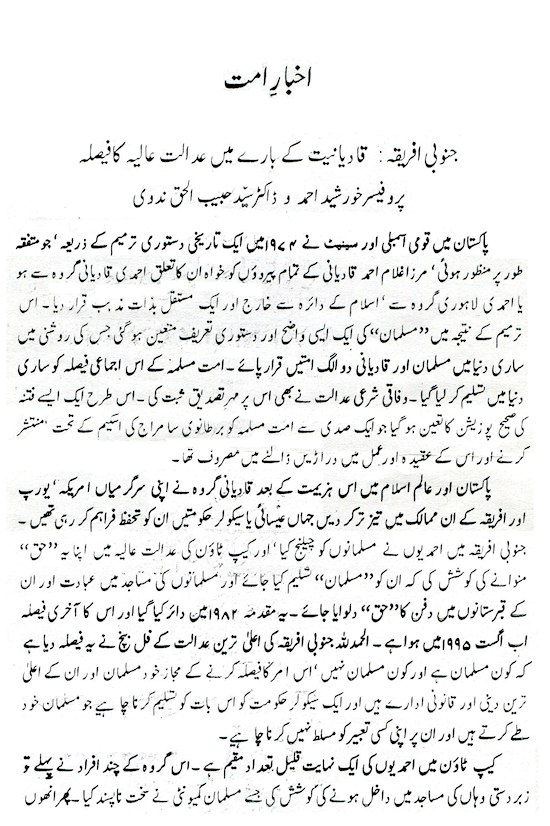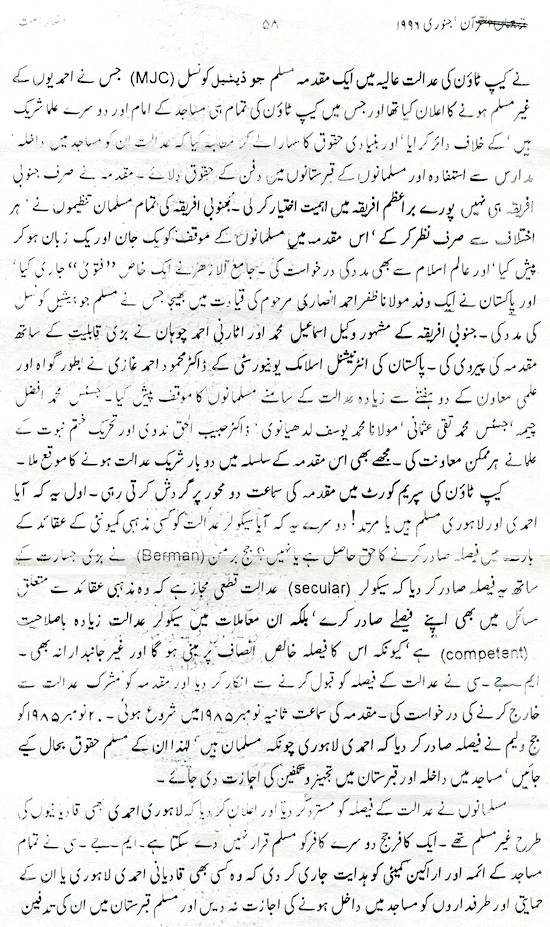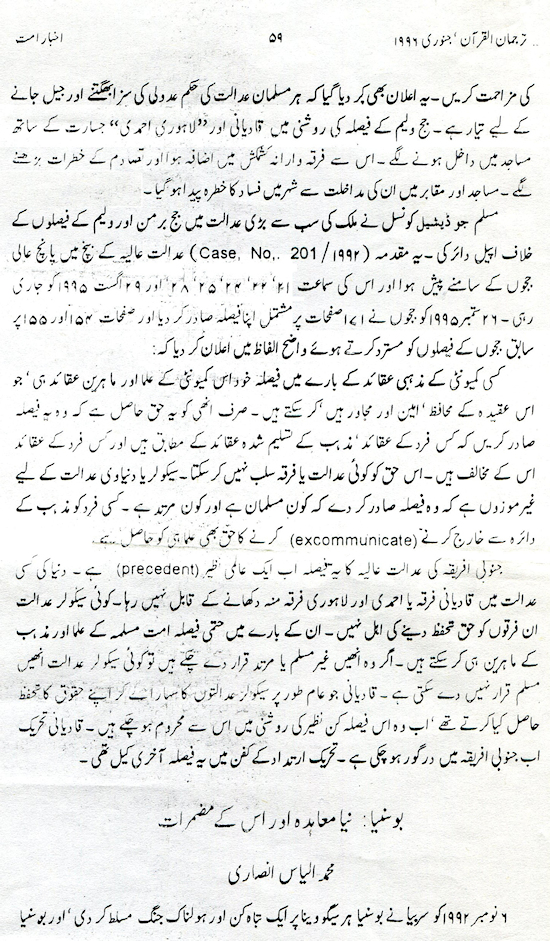3. False propaganda
by our opponents
(Prof.
Khurshid Ahmad’s news article translated)
The following is the translation
of an Urdu article which appeared in the Pakistan magazine Tarjuman-ul-Quran, in its issue for January 1996 in the section Akhbar Ummat on pages 57 to 59. The chief author,
Prof. Khurshid Ahmad, is a well-known Senator in Pakistan belonging
to the Jamaat-i-Islami political party, and a writer and spokesman
on Islam of long experience.
For the original Urdu article, please see further below.
For our response to this propaganda, please see this link.
South Africa:
Court judgment
about Qadianism
by Prof. Khurshid Ahmad
and Dr Syed Habib-ul-Haq
Nadawi
In 1974 the National Assembly and the Senate in Pakistan, by means
of a historic constitutional amendment which was passed unanimously,
declared all the followers of Mirza Ghulam Ahmad of Qadian, whether
belonging to the Qadiani group or the Lahore group, as expelled from
the fold of Islam and as a separate religion. As a result of this amendment,
a clear and constitutional definition of ‘Muslim’ was established, according
to which the Muslims and the Qadianis of the whole world were declared
as two separate religious nations. This decision by consensus of the
Muslim umma was accepted in the whole world. The Federal Shariah
Court also stamped the seal of confirmation upon this. In this way,
a mischief was given its true place, which for one century, under a
scheme of British imperialism, had been dividing the Muslim umma and undermining its beliefs and practices.
After this humiliation in Pakistan and the Islamic world, the Qadiani
group stepped up its activities in America, Europe and those African
countries where Christian or secular governments were providing them
with security. In South Africa the Ahmadis challenged the Muslims, and
went to the court in Cape Town to get their ‘right’ accepted that they
are ‘Muslims’, and to get their ‘right’ of worship in Muslim mosques
and of burial in Muslim cemeteries. This suit was filed in 1982 and
its final judgment has now been given in August 1995. Praise be to God,
that the full bench of the highest court of South Africa has given the
verdict that it is the Muslims themselves and their highest religious
and legal bodies who are authorised to determine who is a Muslim and
who is not a Muslim, and that a secular government must accept what
the Muslims themselves decide and not impose its own interpretation
upon them.
In Cape Town there is a very small number of Ahmadis. Some members
of this group first tried to force their way into mosques, which was
intensely disliked by the Muslim community. Then they filed a court
case in the High Court of Cape Town against the Muslim Judicial Council
(MJC) which had declared Ahmadis to be non-Muslims, and which includes
within it the imams of all the mosques of Cape Town and other ulama.
They demanded on the basis of human rights that the court grant them
the rights of entry into mosques, of use of schools, and of burial in
the Muslim cemeteries. The case acquired importance not only in South
Africa but in the entire African continent. All the Muslim organizations
of South Africa, ignoring any differences between them, united as one
and with one voice presented the view-point of the Muslims in this case,
and they also appealed to the Islamic world for assistance. Al-Azhar
University issued a special fatwa, and from Pakistan a delegation
was sent under the leadership of the late Maulana Zafar Ahmad Ansari
to help the MJC. The famous advocate of South Africa, Ismail Mohammad,
and attorney Ahmad Chohan, pursued the case most ably. Dr. Mahmud Ahmad
Ghazi of the International Islamic University of Pakistan, as a witness
and scholarly advisor, presented the Muslim view-point before the court
for more than two weeks. Justice Muhammad Afzal Cheema, Justice Muhammad
Taqi Usmani, Maulana Muhammad Yusuf Ludhianvi, Dr. Habib-ul-Haq Nadawi,
and the ulama of the Finality of Prophethood Movement gave every
possible assistance. I myself had the occasion to participate in court
twice in connection with this case.
The hearings of the case in the Cape Town Supreme Court revolved around
two points. Firstly, whether Ahmadis and Lahoris are Muslim or apostate.
Secondly, whether a secular court has the jurisdiction to issue judgments
about the beliefs of a religious community. Judge Berman gave the judgment
very boldly that a secular court definitely has the power to issue judgments
about matters relating to religious beliefs, and even that a secular
court is more competent in these matters because its judgment would
be entirely fair and impartial. The MJC refused to accept the verdict
of the court and applied to have the case dismissed from the unbelieving
(mushrik) court. The case was heard in November 1985. On 20th
November 1985, Judge Williamson gave the ruling that since Lahore Ahmadis
are Muslims their Muslim rights should be restored. They should be allowed
to enter mosques and use the cemetery for burial.
The Muslims rejected the judgment of the court and announced that the
Lahore Ahmadis too, like the Qadianis, are non-Muslims. A kafir judge cannot declare another kafir as a Muslim. The MJC issued
the instruction to all the imams of the mosques and members of the committees
not to allow any Qadiani, Ahmadi or Lahori or their sympathisers and
supporters to enter mosques, and to oppose their burial in the Muslim
cemetery. It was also announced that every Muslim was willing to bear
the penalty and go to prison for breaching the order of the court. Due
to the judgment of Judge Williamson, Qadianis and Lahori Ahmadis began
to enter mosques boldly. This led to an increase in sectarian conflict,
and the dangers of clashes escalated. Due to their intervention in the
mosques and cemeteries, there was a risk of a riot in the city.
The MJC filed an appeal in the highest court of the land against the
judgments of Berman and Williamson. This case, Case No. 201/1992, was
put to five judges of the appeal court, and the hearing was held on
21, 22, 24, 25, 28 and 29 August 1995. On
26 September 1995 the judges issued their judgment consisting of 171
pages. On pages 154 and 155, rejecting the judgments of the previous
judges, they declared in clear words that:
Matters relating to the religious beliefs of any community can only
be decided by the ulama and theological experts of that community,
who are the custodians, guardians and trustees of that creed. Only
they have the right to give a decision as to whose beliefs are in
accordance with the accepted beliefs of the faith and whose beliefs
are opposed to them. This right cannot be taken away by any court
or group. It is inappropriate for a secular or worldly court to give
a decision on who is a Muslim and who is an apostate. The ulama also
have the right to excommunicate any person from the religion.
This judgment of the highest court of South Africa is now an international
precedent. The Qadiani sect, or the Ahmadis and Lahori sect, cannot
now show their face in any court in the world. No secular court is competent
to give them protection. The absolute decision about them can only be
given by the ulama of the Muslim umma and its religious
experts. If they have declared them as non-Muslim or apostate, no secular
court can declare them as Muslim. The Qadianis, who used to try to get
the support of secular courts to safeguard their rights, have now been
deprived of this in the light of this decisive precedent. The Qadiani
movement is now finished in South Africa. This judgment was the last
nail in the coffin of the movement of apostasy.
END OF TRANSLATION OF ARTICLE
Our Comment:
The sentence in Professor
Khurshid Ahmad’s article above:
On 26 September 1995 the judges issued
their judgment consisting of 171 pages.
indicates that he has seen a copy of the appeal judgment, and this proves
that his misrepresentations and distortions of the facts in this article
are deliberate and intentional.
Image of the original Urdu article from Tarjuman-ul-Quran
Shown below are images of the three pages from Tarjuman-ul-Quran on which this article appeared.



|


